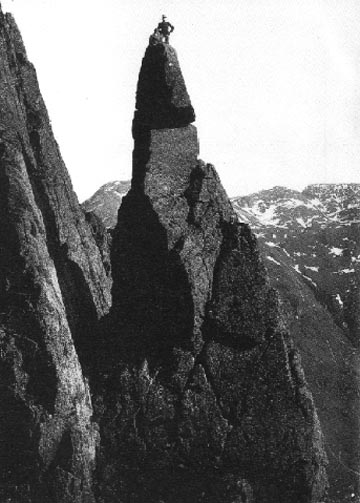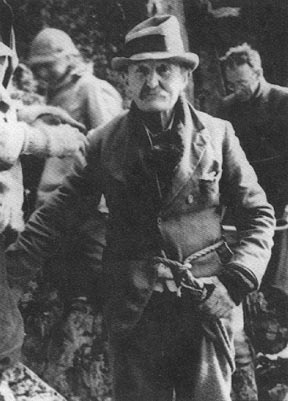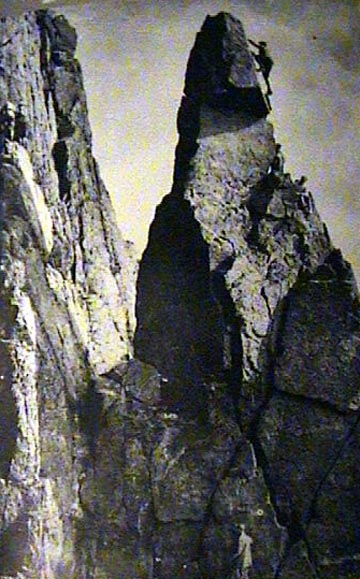
In June 1886, W.P. Haskett Smith made the first ascent of Napes Needle, solo, and left his white handkerchief on top 'fluttering in the breeze', an event widely regarded as the beginning of the sport of rock climbing.
The First Ascent of Napes Needle
June 29th 1886
by WP Haskett Smith
 |
In June 1886, W.P. Haskett Smith made the first ascent of Napes Needle, solo, and left his white handkerchief on top 'fluttering in the breeze', an event widely regarded as the beginning of the sport of rock climbing.
|
| Extract from the FRCC Journal, No.8, 1914 ...........continuing down into the gap and now warmed by exertion, I forgot my headache and began to examine the Needle itself. A deep crack offered a very obvious route for the first stage, but the middle portion of this crack was decidedly difficult, being at that time blocked with stones and turf, all of which has since been cleared away. Many capable climbers were afterwards turned back when trying to make the second ascent not by the sensational upper part but by this lower and (under present conditions) very simple piece.
From the top of the crack there is no trouble to reach the shoulder, whence the final stage may be studied at ease. The summit is near, being as they say in Transatlantic cities "only two blocks away", but those same blocks are set one upon the other and the stability of the top one looks very doubtful. My first care was to get two or three stones and test the flatness of the summit by seeing whether anything thrown-up would be induced to lodge. |

WP Haskett Smith 1936 |
|
| If it
did, that would be an indication of a moderately flat top, and would hold
out hopes of the edge being found not too much rounded to afford a good
grip for the fingers. Out of three missiles one consented to stay,
and thereby encouraged me to start, feeling as small as a mouse climbing a
milestone.
Between the upper and lower blocks, about five feet up, there is a ragged horizontal chink large enough to admit the toes, but the trouble is to raise the body without intermediate footholds. It seemed best to work up at the extreme right, where the corner projects a little, though the fact that you are hanging over the deep gap makes it rather a "nervy" proceeding. For anyone in a standing position at the corner it is easy to shuffle the feet sideways to the other end of the chink, where it is found that the side of the top block facing outwards is decidedly less vertical. Moreover, at the foot of this side there appeared to my great joy a protuberance which, being covered with a lichenous growth, looked as if it might prove slippery, but was placed in the precise spot where it would be most useful in shortening the formidable stretch up to the top edge. Gently and cautiously transferring my weight, I reached up with my right hand and at last was able to feel the edge and prove it to be , not smooth and rounded as it might have been, but a flat and satisfactory grip. My first thought on reaching the top was one of regret that my friends should have missed by a few hours such a day's climbing, three new things, and all good; my next one was of wonder whether getting down again would not prove far more awkward than getting up! Hanging by the hands and feeling with the toes for the protuberance provided an anxious moment, but the rest went easily though, though it must be confessed that it was an undoubted satisfaction to stand once more on solid ground below and look up at my handkerchief fluttering in the breeze.
|
||
 |
Climbers on the
Needle and Needle Ridge
Abraham Collection |
|
| Also see first mountain rescue recorded by John Ruskin in 1859 and Coleridge's descent of Broad Stand in August 1802 |